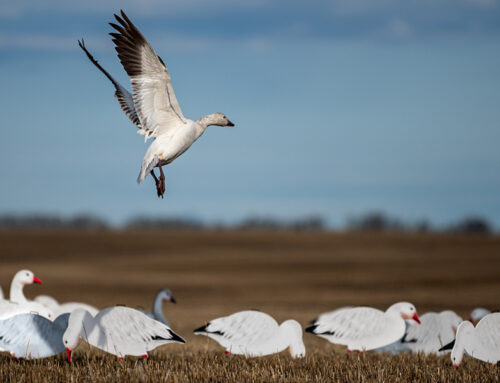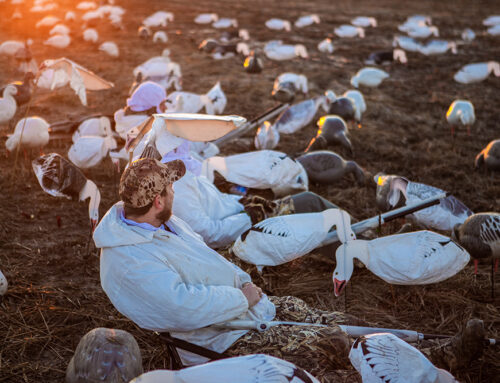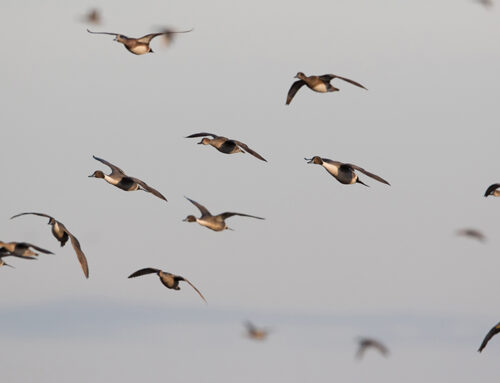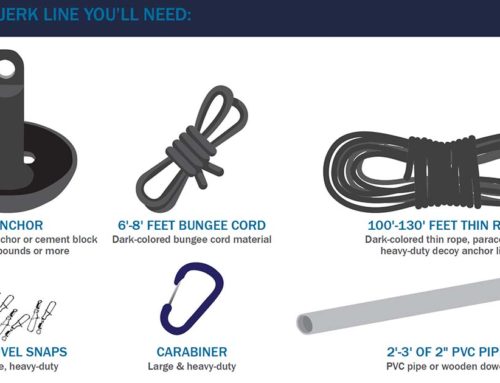Snow Geese Over Water

By Kyle Wintersteen, Managing Editor
Given the popularity of employing massive field spreads to pursue snow geese, hunters under 30 years old might be surprised to learn that it wasn’t always so. Yes, back in grandpappy’s day not only were there far fewer snow geese, most of them were shot over water. Farmers hadn’t yet begun cultivating vast fields of the same crop, and it wasn’t until sometime in the mid-20th century that the birds began using waste grains.
 Hunting snows over water might be an old-school tactic, but it remains an effective means to escape the crowds and decoy birds in their less-pressured loafing areas. And oh, what fun.
Hunting snows over water might be an old-school tactic, but it remains an effective means to escape the crowds and decoy birds in their less-pressured loafing areas. And oh, what fun.
“Snows often glide in low on the deck over water rather than decoy down from high above,” said Dan Faith, a game warden and former waterfowl technician for New Jersey Fish and Wildlife. “It’s exciting, and there’s nothing much better than a goose splashing hard on the water.”
If you’re ready to try your luck hunting snow geese the traditional way, here are some tricks to hunting them outside the farm.
Don’t Forget the Windsocks
Hunting water means using floater decoys, but snows tend to require a sizeable spread and you can only pack so many in a boat. That’s why Faith, who hunts the islands of salt marshes and bays, packs about 20 dozen windsock-style decoys in the bow.
“I know a guide who packs in about 150 full-bodies, but most guys don’t have that kind of space,” Faith said. “I can pack about 500 socks into my boat without much of a hassle.”
When the terrain allows — grassy islands or sandbars are ideal — Faith positions floaters in front of his boat blind according to the wind, then disperses sock-style decoys behind him on land as if the birds are hopscotching back and forth. While he targets the Atlantic coast, the strategy is effective for more inland rivers, lakes, and ponds amidst agriculture.
“I don’t follow any particular shape, I just want the wind and sun at my back or crossing,” Faith explained. “We’ll hunt from the edge of the bank and shoot birds as they land in the water or behind us in the socks.”
Downsize the Decoys
Still, compared to a massive field spread, that’s not many decoys, and, in fact, Faith only rounds out his socks with about two-dozen floaters.
“You wouldn’t even have a fighting chance with that many decoys in a field,” Faith said. “You can be consistently successful with fewer decoys over water because the birds bounce around a lot and travel in smaller family groups. You’re not going to get that big tornado of birds unless you’re in a field, but you’ll get trickles of small groups and pairs.”
Stretch Your Spread
According to Faith, one of the biggest mistakes people make both on land and over water is bunching the decoys too tightly. If you only have room for a couple dozen floaters, spreading them on the surface lends a relaxed look to the loafing fakes and adds visibility. It also plays on the bird’s instinctive tendencies.
“Snow geese tend to work down vertically, but stretching the rig helps get them lower to the water and work on up to the meat of the spread,” Faith said. “I don’t pack that many socks, but I’ll spread them out over 100 yards, and the farther away I get, the thinner I’ll get with them until I’m just placing little pairs and singles. Snows are always hopping over one another kind of playfully around the edges of the group as they loaf around water, so that’s also a way to mimic their natural behavior.”
Scout the Fields
Just because you’re targeting geese over water doesn’t mean you should neglect scouting fields. If you find where the birds are feeding, it’s all the easier to zero in on where they’re headed to wash down the meal.
“Sometimes I’ll see birds work to a particular spot on the bay and try to be as close to the X as possible, but they can be less consistent with where they want to go over water,” Faith said. “Through scouting you develop a good idea of the vicinity where they’re going to fly from feeding areas to loaf, and then you can setup and draw traffic.”
Easy on the Calling
Hunters are often inclined to err on the side of aggression when it comes to snow geese, but like Canada geese, they’re less vocal on the water. Your calling should mirror that.
“If we’re in a conservation season, I’ll have the e-caller going, but not very loudly or aggressively — mostly just feeding murmurs,” Faith said. “Low-key calling is definitely more realistic. Some guys think you need to throw everything you have at them and crank that caller, but I think that can hurt as much as help. It can definitely blow birds out as they’re finishing, because geese just don’t make a bunch of racket on the water.”
Hunting water seldom produces those days when you can empty an unplugged gun at snows and perhaps wish you had an extended magazine tube. Yet it’s more reliable, assuming you did your scouting homework.
“Fields can really be feast or famine,” Faith said. “I may kill fewer birds overall than guys who target fields, but I’m probably getting skunked less, too. Plus, there’s something I love about a little flock of 8 to10 coming, just floating on in over water. Once I got a taste of it, I found it addictive.”






A burnt marsh is a gold mine for snow geese, it draws them in like flies.
I hunt over water in missouri and have many flocks in that i have been able to get high numbers because of my 10 shot extended tube. Also the birds tend to finish much closer than in a field offering first shots at 10 to 15 yards.